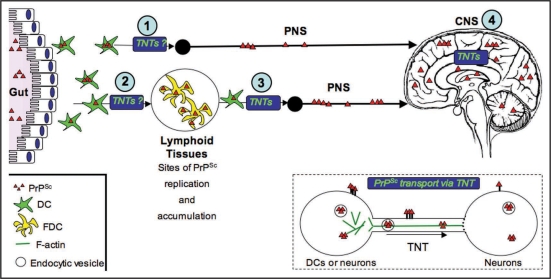Figure 2.
Transport of PrPSc via TNTs, an alternative spreading mechanism during neuroinvasion. Studies in our laboratory suggest that TNTs allow for the intracellular transport of PrPSc between dendritic cells and neurons and between neurons (see inset). The exact mechanism of transport remains to be determined. For instance, it is still not clear, whether PrPSc is strictly transported within endocytic vesicles, or whether it can slide along the surface or be transported as aggregosomes within the tubes. Similarly, the types of motors used, as well as the possible gated mechanisms to enter the recipient cells are not known. Because of the high propensity of DCs to form TNTs with different cell types, we propose that TNTs could play important roles in delivering PrPSc to the proper cell types along the neuroinvasion route. For instance, DCs could deliver PrPSc from the peripheral entry sites to FDCs in the secondary lymphoid tissues (2) or in a less efficient manner, they might occasionally directly transport PrPSc to the PNS (1). They could also bridge the immobile FDC networks and the PNS (3), since we have shown that DCs can form TNTs with nerve cells. Finally, once PrPSc has reached its final destination within the CNS, TNTs might play a final role in the spreading of PrPSc within the brain between neurons and possibly between neuronal cells and astrocytes (4).

